Click here to print
From Coitus Interruptus to Guaranteed-to-Last
posted September 11, 2014
Curt McDowell’s “Sparkle’s Tavern,” a landmark of art porn, will shine on, thanks to a grant to the University of California-Berkeley Art Museum and Pacific Film Archive from the National Film Preservation Foundation
n
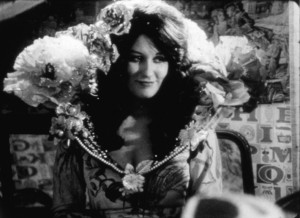 In 1984, or anytime, attempting a complicated projection system at a film festival premiere was a risky proposition. And so it proved for Curt McDowell’s Sparkle’s Tavern.
In 1984, or anytime, attempting a complicated projection system at a film festival premiere was a risky proposition. And so it proved for Curt McDowell’s Sparkle’s Tavern.
The idiosyncratic feature film was to have gloriously met the world that year at the Seattle International Film Festival, but the event was a disaster. Few in attendance managed to outlast a series of projector snafus and make it to the end of the 120-minute, semi-autobiographical, black-and-white, 16mm feature.
I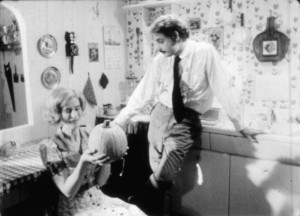 t must have been a terrible disappointment for everyone — advance notice of the film’s extraordinary content had built up great anticipation. It would be the tale of a mother (Marion Eaton) who believes that her son (Jerry Teranova) is working as a school teacher while her daughter (Melinda McDowell Milks, the director’s younger sister) is enrolled as a school student, when in reality they are wriggling free of mother’s smothering Midwestern puritanism by performing both onstage and backstage at a cabaret tavern.
t must have been a terrible disappointment for everyone — advance notice of the film’s extraordinary content had built up great anticipation. It would be the tale of a mother (Marion Eaton) who believes that her son (Jerry Teranova) is working as a school teacher while her daughter (Melinda McDowell Milks, the director’s younger sister) is enrolled as a school student, when in reality they are wriggling free of mother’s smothering Midwestern puritanism by performing both onstage and backstage at a cabaret tavern.
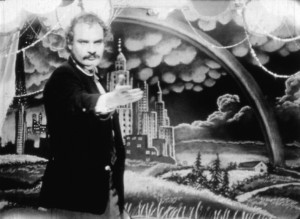
Top: Sparkle (Melinda McDowell) savors the applause. Middle: Mr. Pupik (George Kuchar) and Mrs. Blake (Marion Eaton) after her “instantaneous trip.” Middle: Mr. Pupik introduces Sparkle’s performance. Above: Time to get busy.
Nor can mother see that her son is gay and her live-at-home daughter, while she may aspire to become a “legitimate entertainer,” for now is turning tricks and can exclaim, “If they like the way I sing, how come all my encores are in the backroom?”
But the film had moments of uplift, too. One led Time Out to characterize the film as an “underground queer feature”: at one point, “moms gets a visit from a fairy (a literal fairy) and gets some sex-positive schooling.”
The over-all result was “a lusty, bizarre, sexually-dripping marvel of the emotional dangers in a dysfunctional family crippled with secrets and lost passions,” according to Internet Movie Database. Sparkle’s Tavern stands as an important contributor to the flourishing expression of sexual identity in San Francisco from the 1960s and 1970s, on.
That explains why the National Film Preservation Foundation has provided support to the University of California at Berkeley’s Art Museum and Pacific Film Archive for ongoing upkeep of the film. (In June this year, 2014, the NFPF made grants as part of its annual cycle of support for films deemed historically important to 35 institutions.)
McDowell shot the film in 1976 and 1977, in San Francisco, but he couldn’t afford to finish it. In 1980 he lamented not having a flatbed editor to facilitate his organization of his footage, exclaiming: “It’s R-rated, it’s funny. It’s about enlightenment. It’s about hiding things from your parents and them hiding things from you.”
 In the interim, McDowell (1945–1987) kept busy. Originally a painter, he eventually made about 30 films. English filmmakers Daniel Fawcett and Clara Pais wrote in a 2012 appreciation that his body of work would exhibit “an original range of approaches to smut cinema, from raw documents of his sexual experiences to films like Thundercrack!, Bogey Depot, and Sparkle’s Tavern, humorous mishmashes of genres, mixing porn, horror, burlesque musical, and soap-opera.”
In the interim, McDowell (1945–1987) kept busy. Originally a painter, he eventually made about 30 films. English filmmakers Daniel Fawcett and Clara Pais wrote in a 2012 appreciation that his body of work would exhibit “an original range of approaches to smut cinema, from raw documents of his sexual experiences to films like Thundercrack!, Bogey Depot, and Sparkle’s Tavern, humorous mishmashes of genres, mixing porn, horror, burlesque musical, and soap-opera.”
Thundercrack! (1975) destined McDowell for cult status. It turns on a storm driving a variety of horny individuals to a gothic mansion inhabited by a lonely woman who has been widowed by rapacious locusts. Marion Eaton, who had starred in and financially saved the production of Sparkle’s Tavern, plays the widow. “She appears,” Fawcett and Pais wrote, “to have applied her make-up in the dark and staggers around her home in a black slip” rambling in “that unmistakable style of the film’s writer George Kuchar, which is tragic, vile, hilarious, and sensitive in equal measure.” While the widow bonks the guests under garish lighting and in black and white, her guests rattle on about how they feel.
The result, wrote Fawcett and Pais, “would be standard pornographic scenes if it wasn’t for the characters constant monologues about their feelings. This marriage of poetic rambling and hardcore sex serves the purpose of revealing the connections between their sexual behaviours and their emotional traumas.”
McDowell’s sister Melinda had come to San Francisco to join her brother at the time the shooting of Sparkle’s Tavern began. He viewed the film as a homage to her, and invited her to take part even though she was not an actor. Her later roles included a lead in her brother’s 1980 Taboo: The Single and the LP. Roxie,the San Francisco film nonprofit, described that 22-minute piece as “one of McDowell’s most ambitious (and most ambiguous) films,” a “mixture of documentary and psychodrama featuring a series of sexually charged vignettes inspired by a piece of graffiti found inside a toilet stall at the Maritime Museum. Though none of the film’s action ever reaches a level of genuinely explicit sexuality, the anticipation of its doing so haunts the film’s tense 22-minute running time.”
Eaton also had key roles in projects by filmmakers in McDowell’s circle, including The Devil’s Cleavage (1975) by the writer of Thunkercrack!, George Kuchar. Kuchar was a key figure on the San Francisco underground cinema scene after arriving in the city in the early 1970s from New York, where he had been making films since his teens and showing them with the likes of Jonas Mekas and Andy Warhol. While teaching at the San Francisco Art Institute, he met McDowell, who was studying painting there.
All the while, Sparkle’s Tavern awaited completion. One disappointment for McDowell, explains media historian Kevin Heffernan in his essay in the 2012 collection Peep Shows: Cult Film and the Cine-Erotic, was that he made Thundercrack! in what he thought – incorrectly – was a commercially viable style in order to raise money for “more personal projects” like Sparkle’s Tavern. But changes to federal tax law came into force that limited tax deductions to motion-picture investors to the amount at risk, which seems a reasonable measure. McDowell was unsuccessful in seeking funding from the American Film Institute’s Independent Filmmaker Program in 1978 and from the National Endowment for the Arts.
Then in 1982 the project got a puff of life when McDowell did receive a grant from the National Endowment for the Arts. By 1984 an edited work print was ready in time for a screening at the Castro Theater in the 8th San Francisco Gay and Lesbian Film Festival. It was also shown in Mill Valley.
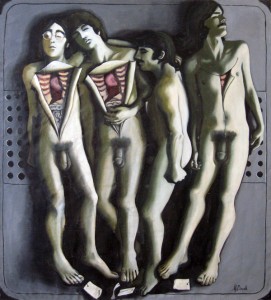
Curt McDowell, who originally intended to be an artist, lays bear the Beatles. In addition to making his 30 films, he also wrote screenplays, designed sets, and costumes.
Eaton (1932-2011), who had played the mother in the film as a favor to McDowell, raised money to have the original conformed and a new print struck. She was, in fact, the film’s primary financial supporter.
Even then, however, the film’s screening history remained scrawny — it’s hardly the easiest sell. Among its few runs have been 1992 and 1993 presentations in Europe. There, and back where it was supposed to begin its public life, in Seattle. In The Seattle Times in 1992, John Hartl wrote that “although this coming-out story includes none of the hard-core footage that turned Thundercrack! into a unique mixture of porn, tongue-in-cheek Joan Crawford melodrama, old-dark-house thriller and Warholian star power, it’s just as indiscriminately carnal. McDowell’s polymorphous-perverse approach, which one critic defined as ‘Whitmanesque pansexuality,’ is all-accepting.”
Hartl’s response was mixed. He called the film a “raunchy underground movie” that has “its amateurish touches – washed-out photography, scratchy soundtrack – while the script wallows in repetitious vulgarity for half an hour before it begins to click. But there are moments in the second half, including an ‘I hate the Midwest!’ outburst and an outraged monologue about the kind of family that has no vacuum cleaner (!), that are reminiscent of John Waters’ most delirious assaults on suburbia.”
Hartl added: “As in Thundercrack!, Eaton triumphs with a performance that thrives on sweet, goofy naivete. Her orgasmic enlightenment scene, with Kuchar playing a liberating doctor who shows her how to “trip into inter-linear time,” is simultaneously outrageous and endearing.”
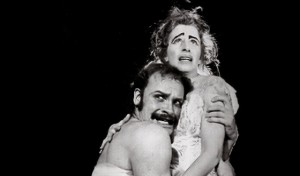 Despite being little screened, Sparkle’s Tavern enjoys a certain renown. Promoting a tribute to McDowell, the San Francisco film coop Roxie referred to McDowell as “beloved avant-garde filmmaker.” In an overview of McDowell’s films and life, the always-fascinating The Underground Film Studio (which is associated with the Film Panic fanzine) pays homage to the art-porn master and asserts his bona fides as a cult figure:
Despite being little screened, Sparkle’s Tavern enjoys a certain renown. Promoting a tribute to McDowell, the San Francisco film coop Roxie referred to McDowell as “beloved avant-garde filmmaker.” In an overview of McDowell’s films and life, the always-fascinating The Underground Film Studio (which is associated with the Film Panic fanzine) pays homage to the art-porn master and asserts his bona fides as a cult figure:
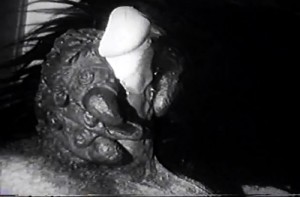
Three stills from “Thundercrack!” Not everyone’s cup of tea.
“Curt McDowell is unfairly missing from most histories of cinema, his name occasional pops up with a brief mention of Thundercrack! but he certainly isn’t as celebrated and studied as much as he deserves to be. We suspect that the lack of interest from the serious-minded film scholars is due to the limited availability of his work, it is unlikely that most of them have seen his films. If any they may have seen Thundercrack! which we wouldn’t be surprised is dismissed as a quirky low budget porn novelty. It is only when you see more of his films that you can understand the depth of his explorations of sex through cinema.”
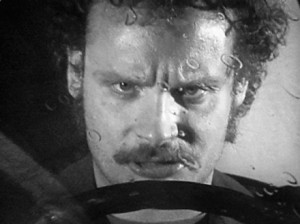 As for Sparkle’s Tavern, specifically, the homage suggests it “is a highly autobiographical melodrama that came about because Curt wanted to make a pro-sex film about his family. [Film curator and author] Jack Stevenson has suggested Curt was creating ‘a séance as much as a movie,’ digging deep into his own feelings towards his family, and recreating and reliving a situation from his life.”
As for Sparkle’s Tavern, specifically, the homage suggests it “is a highly autobiographical melodrama that came about because Curt wanted to make a pro-sex film about his family. [Film curator and author] Jack Stevenson has suggested Curt was creating ‘a séance as much as a movie,’ digging deep into his own feelings towards his family, and recreating and reliving a situation from his life.”
Filmed on 16mm black-and-white reversal film, Sparkle’s Tavern is on five reels totaling 120 minutes. BAM/PFA acquired the film elements that will be used for preservation — the film’s only known surviving materials — from Marion Eaton (who died in 2013) and Jack Stevenson.
Also with a grant from NFPF, Berkeley Art Museum and Pacific Film Archive preserved an earlier key McDowell film, the 22-minute A Visit to Indiana (1970). Ainslee Mac Naughton described it in 2011 on the CUIndependent site: “The film chronicled a trip home to the Midwest to visit his family and focused on McDowell’s disillusionment of returning to Indiana, where things are static and very different than the explosive Bay Area. McDowell and a friend discussed his family over images of Indiana, from car rides to family gatherings. It felt like watching an old home movie, but the narration was comical and intentional. When asked about his father’s hobbies, McDowell replied, ‘He likes being a good father; and welding; and eating.’”
McDowell died from AIDS in 1987. His friend and collaborator George Kuchar summed him up: “Curt was curt, cute, controversial, and not celibate.”
Printed from Moving Image Archive News: https://www.movingimagearchivenews.org
URL to article: https://www.movingimagearchivenews.org/from-coitus-interruptus-to-guaranteed-to-last/
Click here to print